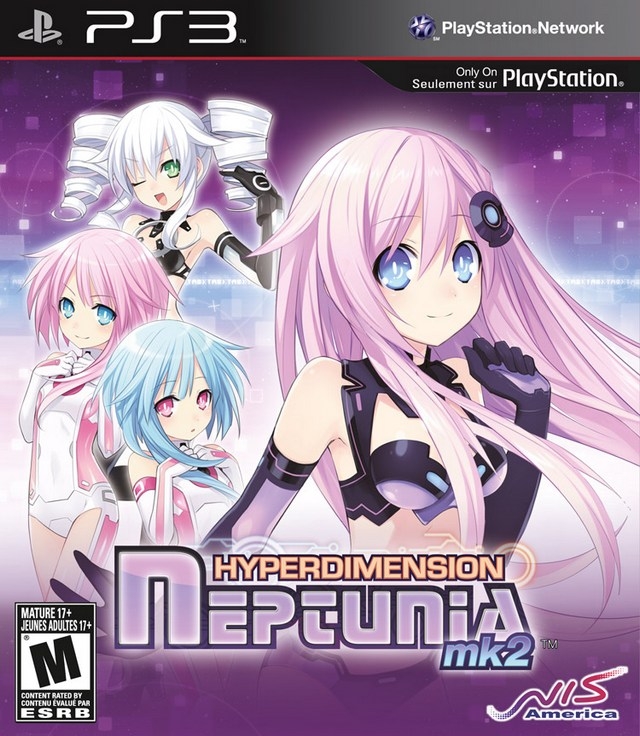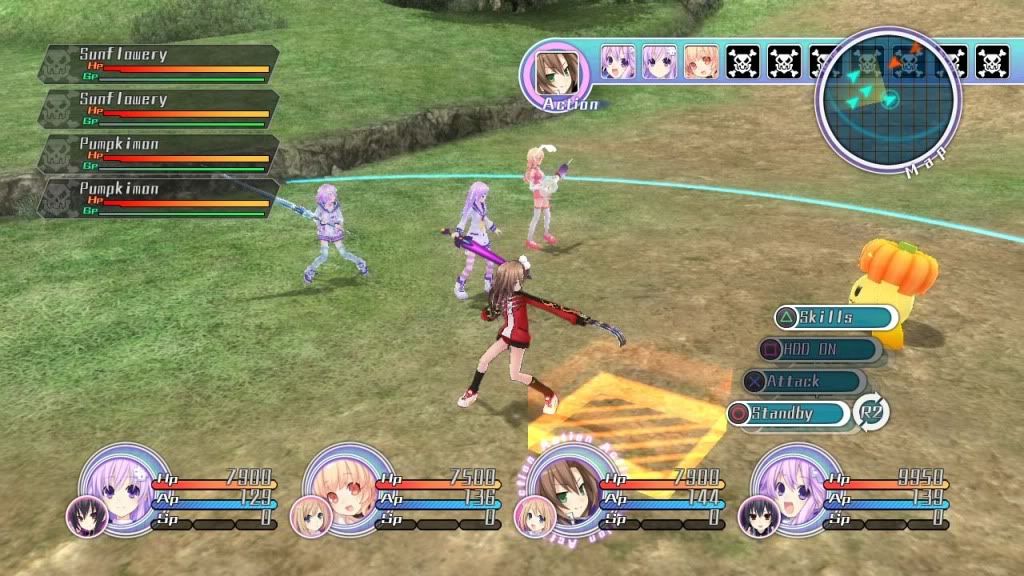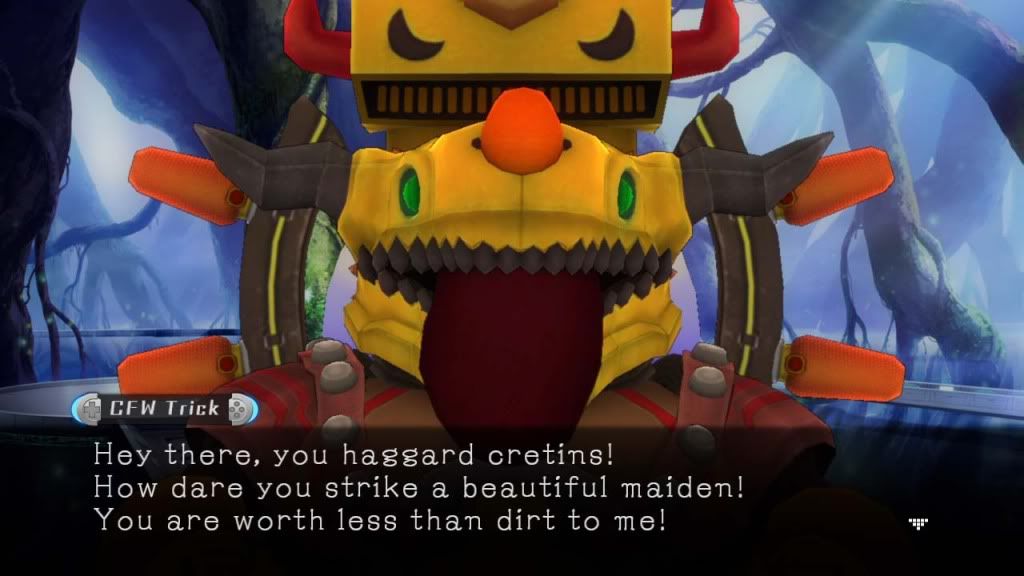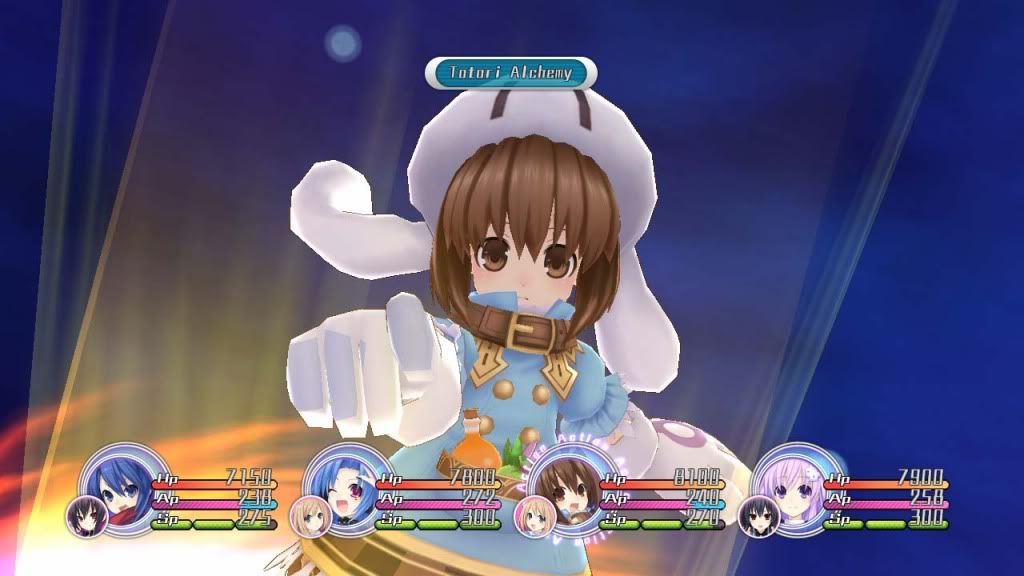Existing User Log In
New User Registration
Register for a free account to gain full access to the VGChartz Network and join our thriving community.





America - Front


America - Back

Hyperdimension Neptunia Mk2 (from now on just called Mk2) is the sequel to one of the most unique gaming concepts of 2011. Playing in the magical “Gamindustri”, a mystical re-imagining of the real life game industry, as a video game console personified as a girl, is at least an interesting idea. The first title never actually managed to get the actual game designed around that concept to match up to its potential, but was a decent experience regardless. I had hoped that Compile Heart and Idea Factory would continue the upswing in quality they had going from Trinity Universe to Hyperdimension Neptunia and Mk2 would be an unequivocally good game. Sadly, while this game does see a few steps forward, I'm afraid it also contains more than a few steps back.

All Female cast of gaming based heroines. Oh, Japan, you crazy!
The first Hyperdimension centered around the CPUs which were consoles personified as heroines. Since the last game those CPUs have been captured and it is left to their CPU candidate sisters to get help from their mascots and save the real CPUs from captivity. These sisters are all based on handhelds, so Neptune is replaced with Nepgear, Lowee gets two candidate twins, and Leanbox actually doesn't get one since Microsoft hasn't made a handheld. As Nepgear, you're tasked with traveling to the four different Gamindustri lands of Planeptune, Lowee, Leanbox, and Lastation (not exactly the most subtle names in the world). Characters that aren't console based are instead based on some of the smaller Japanese developers who agreed to have their companies morphed into girl form, including NISA, Cave, 5pb, Gust, and Falcom. Along the way there are a lot of gaming references like Lastation being attacked by hackers, or Lowee's candidates not being allowed to use 3D on their new handheld because it's not good for developing kids, but these are mostly relegated to side events.
The problem is that the story just doesn't come off as funny the second time around. There are some beneficial changes, like increased “screen time” for the Gust and NISA characters who are still far more interesting than Compa and IF, and adding more Japanese company-based characters is also fun, but the main character change really hurts. Neptune helped make the first game funny, much in the same way that Recette made Recettear as funny as it was. A little ditzy girl making all kinds of off color comments and strange expletives involving pooper scoopering really kept me laughing whereas Nepgear isn't nearly as useful in that regard. Nepgear is more like the well meaning, serious girl who is used as a straight woman for a lot of jokes but is rarely the funny one herself. More of Gust and NISA helped to make up for this deficit, and one of the bosses you face made me laugh with his disturbing fetishes, but that still couldn't make up for the change in main characters completely. Later in the game, Neptune makes a return, but far too little and too late.

That's probably the least creepy thing this dude ever says
So obviously the humor was a step back, but what about the steps forward? Well, most of those are in the realm of gameplay. You still don't have a true overworld map you can explore, but the battle system has been changed to include positioning and movement. This gives you one more thing to consider for boss fights, but isn't usually a notable factor for fighting lesser mobs. You still get a certain amount of AP each turn, which you can spend on attacks using three different options linked to Square, Triangle, and “X”. Triangle is an attack focused on building up a combo with a lot of hits and helps you refill your SP, Square attacks are heavy hits which focus on a single strike with more damage, and “X” are Breakers that take out more than the normal share of your opponents' guard. Like many Compile Heart games, every enemy you face comes with a health bar as well as a guard bar. You can still damage them when the guard bar is full, but you can do significantly more damage if you first get rid of their guard.
Combo building with Triangle or Rush attacks isn't as meaningful as some other games' battle systems, where the higher combo will exponentially increase the damage you're putting out, but it has its uses. Each of your characters has specials they can perform for healing, buffing, or just generally doing far more damage than you could with your usual combo attacks, but these cost SP. SP can be built up in a number of different ways. Every time a character ends a turn they get 10 SP, and taking a hit will give you some SP but the best and easiest way to build it up is to attack the enemy yourself. Every hit you put out gives you SP and when you start using later rush skills to hit 30 or so times in one combo you can quickly get it back. So this is what most fights boil down to: attacking with Breakers and Rushes to increase your SP and help get their guard down, using skills whenever possible, and then once the guard is down attacking with everything you've got. This strategy is only really meaningful when fighting tougher enemies though, so the bulk of your time is just spent attacking with whatever you can muster that'll kill the weaker guys quickly.
One definite improvement is that the back row system from the first game gains meaning much more quickly since you get 9 playable characters just by playing through the main story, and 13 if you put in a little extra work. Characters in the back row are used as reinforcements that can be switched in with the character they are partnered with or just give their partner in the field passive buffs. It would be nice if there were some partner specific skills you could use, but if there are any they didn't make themselves apparent.

Actually kind of wish Twitter was presented like that, guess that makes me a nerd
There are some odd missteps with the battle system though. The first comes from a wonderful idea where you can hit enemies before engaging them to gain the upper hand and have more AP at the start of the fight, and if you greatly overpower them you can instantaneously destroy them without the need to go into the battle screen. Earthbound was the first game I ever played with a system like this, where weaker enemies can be skipped, and I really like whenever it's implemented in games recently, but it doesn't work quite as well in Mk2. In Earthbound, defeating enemies in this way still got you experience and items as though you had beaten them the normal way, but in Mk2 the enemy just disappears and you get nothing.
It makes sense that you don't get experience, since that would quickly break the leveling system, but it would be nice if it at least counted beating those enemies for the quests that you'll want to do over and over again. Each side quest gives benefits beyond just money and items and actually changes the “shares” each nation gets. At first all of these shares are taken up by the evil Arfoire syndicate which has taken over while the CPUs were away, so some of the side objectives involve getting these shares back, which can only be done by completing a large number of side quests. So when I'm going back to the same low level area to kill off the same monsters I've been killing for the past hour it would be really helpful if I could just whack them out of existence instead of fighting them the normal way.
The second misstep is that the item system was reverted back to standard. I know that the old system garnered a few complaints, but I actually liked the extra layer of strategy that it added. In the first game you didn't have items so much as you had program-like lines of commands similar to the battle system in Final Fantasy XII, which used up a general pool of four or so different common items as ingredients. As you leveled your characters they would gain more possible commands and also more points, which you could use to increase the likelihood that any command would happen when the conditions were met. Sure, sometimes the rolls of the dice would screw you over and your 80% likely command to heal when below 30% health would fail twice and your character would die, but it was a unique and interesting system. It makes me sad that instead of working on improving this system it was scrapped in its entirety.

Just makes me want Atelier Meruru that much more
Another system that appears to have been scrapped is the lip synching system that used an independently moving mouth to easily lip synch all of the dialogue. Without this system to showcase it seems as though the developers decided to take the shortcut route for visuals wherever possible with characters talking from off screen often. The audio is similar, with very little voice acting throughout. I don't mind when side quests aren't voice acted but it really doesn't help the presentation of the game when aspects of the main story aren't voiced.
Another sign of cutting corners are the dungeon designs that repeat quite a few times. One dungeon design that was definitely worthy of being reused is one based on a gaming convention floor; designs like these make the best out of the game's general concept. Beating up Tetris blocks subtly named Tetsir, or screens from a dating simulation that whack you with their text boxes, are reminders of what this game could have been. I just wish that they'd gone further with the idea, but maybe legal reasons precluded it. Towns which are displayed as a grouping of “Chirper” feeds is also a nice way to give you some NPCs to listen to, even though the town is all menu based.
I spent about 19 hours beating up Tetsir blocks and wishing Nepgear was Neptune before the credits rolled and I achieved the normal ending. This is a lot shorter than the first game, which took me 31.5 hours to complete, but this is probably at least partially due to the streamlining that the game's travel system creates. There are also a large number of hidden endings, but the requirements for these will either take a second playthrough in New Game+ or judicious use of a walkthrough. I can't really see myself playing through the game all over again (even with the advantage of over leveled characters) to see endings for characters I don't have that much of an emotional attachment to.
Mk2 solidifies the Hyperdimension Neptunia series as one of those great ideas that seems doomed to persistently mediocre execution. Hopes that Compile Heart would continue their upward trend in quality from Trinity Universe and Hyperdimension Neptunia have been dashed, as anything that didn't work in the first game has been ditched (instead of being improved upon), and the main character lost her shine. Fans of the genre will still find the game worth playing, just as I did, but I'm almost glad that there isn't anywhere for the series to go from here.
This review is based on a retail copy of Hyperdimension Neptunia Mk-II for PlayStation 3, provided by the publisher.










| Total Sales |
0.00m
Japan |
0.00m
NA |
0.01m
Europe |
0.00m
Others |
0.01m
Total |
| 1 | n/a | n/a | 108 | 17 | 125 |
| 2 | n/a | n/a | 53 | 9 | 62 |
| 3 | n/a | n/a | 138 | 23 | 161 |
| 4 | n/a | n/a | 88 | 14 | 102 |
| 5 | n/a | n/a | 112 | 19 | 131 |
| 6 | n/a | n/a | 113 | 19 | 132 |
| 7 | n/a | n/a | 77 | 13 | 90 |
| 8 | n/a | n/a | 116 | 19 | 135 |
| 9 | n/a | n/a | 100 | 17 | 117 |
| 10 | n/a | n/a | 69 | 11 | 80 |
|
|
|
|
|
|
|
|
|
|
|
|